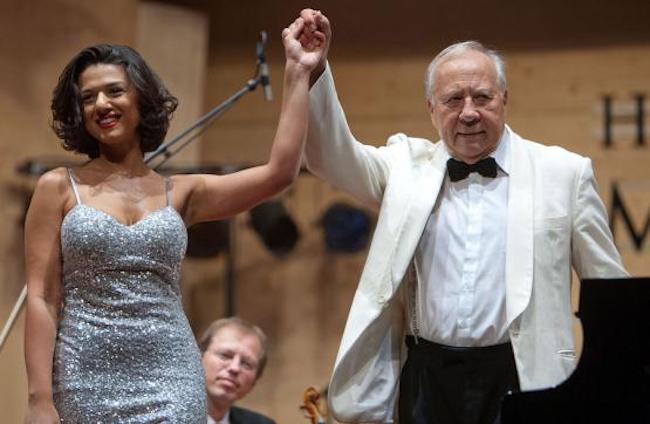Luckily, in the summer of 2011, Estonian-American conductor Neeme Järvi and Georgian concert pianist Khatia Buniatishvili united for a live performance of the piece at Verbier Festival in Switzerland.
Järvi glides gently into the first movement (“Allegro ma non tanto”) with lilting violins, but then the rhythm picks up within a minute with Buniatishvili playing staccato triplets. Movement one expounds upon a frayed state of mind. The chords are choppy and mirror each other up and down the keyboard. The low register of the piano growls. In the song's most troubled moments, trumpets signal the finality of despair. Yet, the audience is given a respite and feeling of redemption as Järvi advances the entire string section of the orchestra, or sweeps over with clarinets and oboes.
Other performances of this concerto can result in a delivery that's too tightly wound up, or alternatively something chaotic without grounding and a return to melodic origins. But here, Buniatishvili attacks with fluidity and purpose.
The second movement (“Intermezzo: Adagio”) reduces the orchestra's force quite heavily, with a focus on sorrowful voicings. The audio mixing starts to shine here: we can perceive just enough of the softest notes to enjoy their delicacy, while not being diluted with compression. Throughout this movement, violins and cellos are the most present and outspoken instruments, arriving in gusts.
The third movement (“Finale: Alla breve”) rushes in without a pause, with the orchestra giving us the main message of the concerto. We hear the composer's flair for descending chromatically. The triplets from before return with full force. In the last moments of the concerto, there is a feeling of incandescent bliss as the piano hits the high register harmoniously with the entire orchestra, from the percussion section down to the apron of the stage.
To capture the torment of this piece, disregarding its technical complexity, must involve the musical equivalent of method acting. But, as we see in all of the hardest working musicians around, Buniatishvili and Järvi make it look effortless. Engaged, but effortless.
Buniatishvili is closely associated with Verbier Festival, with solo performances of hers drawing large crowds in 2011, 2012, and 2013, not to mention playing countless concert venues from the Royal Albert Hall to La Scala in Milan. Järvi has also conducted again at Verbier Festival subsequent to this concert.
The Swiss festival says its mission is “to build a community of exchange between great masters and young artists from all over the world…” Buniatishvili is already a master, but it is true that her and Järvi are strengthening the following of classical music through their gracious and charismatic style of collaboration, as titans of the genre.
Watch the full performance on YouTube and medici.tv to see their attentive handling of this piece for yourself.
Written by Vincent Teetsov, Toronto




